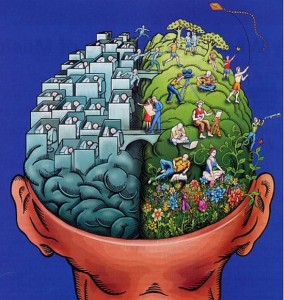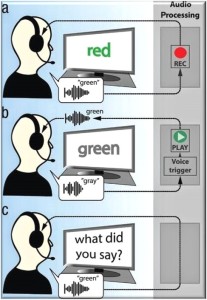The following post is by guest Gary Weber, Subject/collaborator in neuroscience studies at Yale, Institute Of Noetic Sciences, Baumann Institute, Center for Study of Non-Symbolic Consciousness, Johns Hopkins, Penn State. It accompanies a Voice America Interview about how leaders can manage their thinking to improve their effectiveness. I found the conversation about how the brain actually works and how we manage our thinking versus our perception of what we are doing quite fascinating. For me, the take away was that our brain functions much differently than we were taught and by updating our understanding, we have the opportunity to reduce our stress and improve our effectiveness dramatically.
From Garyâs work: One of our great, and common (mis)conceptions is that we need “thoughts” to speak – that we “think up”, consciously, what we say before we say it. Â As an experiment, take a few minutes and watch carefully what you say, and see if you do think up what you say. Â Go ahead, just do it… Do we know what we’re going to say before we say it? Â Or do we just hear it as it is said, and then try to see if it was a “good” thing or if we might have “misspoken”?
The quieter your internal narrative is, and the closer you watch, the easier it is to see that you have no idea what is going to be coming out when speech happens.
An excellent paper was just published in “Psychological Science” entitled “Speakers’ Acceptance of Real-Time Speech Exchange Indicates That We Use Auditory Feedback to Specify the Meaning of What We Say”, by Andreas Lind, et al., from the Swedish universities at Uppsala and Lund.
What Lind and his colleagues did was to see what would happen if someone said one word, but then heard themselves apparently speaking another word. Â As Lind said âIf we use auditory feedback to compare what we say with a well-specified intention, then any mismatch should be quickly detected. Â But if the feedback is instead a powerful factor in a dynamic, interpretative process, then the manipulation could go undetected.â
So, if the word that was said was different from what we had mentally pre-planned to say, it would be very obvious to us. However, if we routinely have no idea what is going to be said, and only know it when we hear it spoken and then interpret it, the change to a different word will not be seen.
Thought Experiment The image to the left shows how this works. This is the famous Stroop effect/test, which shows you letters that spell a “color” word in the “wrong” color, i.e. it spells out “r-e-d”, but the word is colored “green”. Â It takes a little concentration to do it correctly.
Then in “b”, you are shown “g-r-e-e-n” but it is colored “gray”, and you correctly say “gray”, but your recording of your saying “green” earlier is replayed in your headphone.
In “c”, you are then asked “What did you say”, and you say “green”, even though you really did say “gray”, i.e. you said what you heard, not what you actually said.
Most importantly, this did not seem “strange” to you, i.e. you really believed that you said what you heard, rather than what you actually said. Â If you had premeditated and consciously said “gray”, you would have objected when you heard “green” and said “What i heard in my headphones was not what i said!”
It matters a lot exactly when the “wrong” word is heard in your headphones. Â If the synchronization w/the “voice trigger” in b) was begun within 5 to 20 milliseconds after you began to speak, it was undetected more than 2/3 of the time. Â The 1/3 of the “detections” are effectively less than that. Â They fell into 3 categories, “certain, uncertain and possible”, with only 4% being “certain”.
For you techies, they did use a “noise cancelling” headset so that the 78 subjects wouldn’t be able to hear what they really did say.
These results were a big surprise to Lind, who put himself through the test, knowing what was going on. He felt that the speech exchanges were convincing, and said “âWhen you say one thing but hear yourself clearly saying something else, itâs a very powerful feelingâ.
Research this compelling directly contradicts established dogma, both scientific and societal.
The question is, “However speech manifests, do we consciously pre-plan it with internal narrative?” Â Speech emerges, and some functionality must be creating it, but it isn’t conscious.
Now, back to Maureenâs comments. So, what does this mean for leaders and how they work? One important take away is that as we understand the brain and how it actually works, it is important to step out of this automatic mode as much as possible and into being aware of our own thinking and actions. One way to do this is to ask yourself simple questions designed to help you gently shift from the automatic mode most leaders spend 85% of their time inhabiting and into aware mode. Imagine how much more productive you could be if you spent just 1 hour per day more aware and if you used that hour to do your highest impact work? What could you accomplish?
If you are open to an experiment, try asking yourself something like: where am I now or what am I thinking now? This is a gentle nudge to move you back to working with awareness. I tried this over the past couple of weeks and have found that I am more aware of my incessant multi-tasking in service of managing a complex role within my professional life and many family demands. My personal goal is to find the best path to accomplish my goals and make the greatest positive impact I can. If being more aware helps this process â I am all in. I wonder if it will work for you?
To become a more innovative leader, please consider our online leader development program. For additional tools, we recommend taking leadership assessments, using the Innovative Leadership Fieldbook and Innovative Leaders Guide to Transforming Organizations, and adding coaching to our online innovative leadership program. We also offer several workshops to help you build these skills. www.metcalf-associates.com
Tune in Live every Tuesday at 11am PST to Innovative Leaders Driving Thriving Organizations






